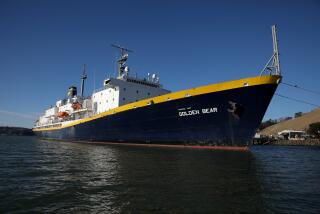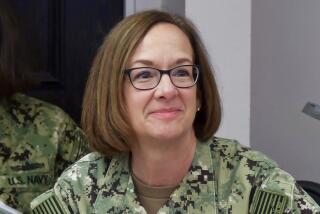In Increasing Numbers, Women Are Mastering the Maritime Profession : Jobs: Historically almost all-male, more female skippers are joining the ranks in the U.S.
- Share via
KINGS POINT, N.Y. — The tug’s tow line snapped and the 600-foot Lyra heaved out of control toward the Frying Pan shoals off Cape Fear, N.C., powerless, crewless and loaded with 387,000 gallons of fuel.
*
A helicopter dropped a captain and three subordinates onto the cargo ship. After eight hours bucking 20-foot swells, they managed to anchor the vessel and avert a catastrophe.
The Jan. 27, 1993, rescue of the Lyra was unusual. So was the captain.
Debbie Dempsey is one of only a dozen or so women in the United States with the highest mariner’s ranking: ship’s captain with an unlimited master’s license. She can command any ship anywhere under any circumstances.
In the history of the real-life water world, where female images historically have been limited largely to ship names and mermaids, few women hold prominent positions. That is changing.
“Women have played a significant and unheralded role in the maritime profession,” said Frank Braynard, curator of the maritime museum at the U.S. Merchant Marine Academy in this Long Island suburb.
Ironically, more women are entering the profession at a time when it is declining as a whole. The merchant marine, the nation’s fleet of mostly private, commercial ships, has fallen from more than 1,000 ships at the end of World War II to about 400 now. Foreign competition is a primary main reason.
Growing numbers of women are earning their stripes in the seven maritime academies from Maine to California, gaining bachelor of science degrees and third mate or third engineer’s licenses, then working through the rankings to captain commercial ships.
It was only in the mid-1970s that maritime schools opened their doors to women, pressured partly by the spirit of women’s equal rights movement.
Now, at Kings Point, which graduated its first women in 1978, 21 of 219 graduates were women. This year’s freshman class includes 30 women.
At the Maine Maritime Academy in Castine, where Dempsey was the first woman to graduate in 1976, eight women were among the 162 graduates this year. The class of 1999 includes 30 women.
Five percent of the Great Lakes Maritime Academy’s graduating class has been female in recent years. This year, however, 8% of freshmen at the school in Traverse City, Mich. are women.
The opportunities for female graduates are great, said Richard Gurnon, dean of students at the Massachusetts Merchant Marine Academy.
“Companies are vying for the services of women with third mate licenses,” he said. “They have discriminated for so long that now they are trying to make up lost ground.”
But it’s not just the demand for qualified women that is encouraging women to take to the seas.
“It’s easier for women now, they have the role models they didn’t have in the past,” said John Staples, spokesman for the Maine academy.
Some graduates already are taking their place in history alongside several heroic 19th-Century mariners, honored by the Kings Point museum. Six of the 50 mariners in its 13-year-old Hall of Fame are women.
In 1856, Mary Patten, 19-year-old daughter of a seafaring man, took over her husband’s cargo ship when he fell ill. Four months pregnant, she put down a mutiny and guided the 1,800-ton clipper with $400,000 of cargo round Cape Horn and up the West Coast to San Francisco.
Another, Nettie Johnson, ran her own Mississippi steamer while she raised three sons. She was the first woman licensed as a master on an inland waterway and helped transport war supplies in 1917.
Ida Lewis, like her father before her the keeper of Lime Rock Light in the harbor of Newport, R.I., until her death in 1911, made 18 daring rescues, navigating her tiny rowboat through storms.
Like these women of history, many of those working on ships today are drawn to the sea despite the long hours, months offshore and the loneliness that comes from often working with no other women aboard.
The allure is the chance to see the world and salaries that start at $35,000 a year. Pay can reach into the $100,000 range for a captain.
Dempsey, who grew up on Long Island Sound in Essex, Conn., worked for several years delivering boats from all over New England to the Caribbean and elsewhere.
“Water was part of my life,” said Dempsey, 46, who now works in Astoria, Ore. as a Columbia River pilot. An on-board guide, she helps ships navigate a 17-mile-long bar ranked among the world’s most treacherous.
After receiving a bachelor’s degree from the University of Vermont, Dempsey was well poised for admission to the Maine Academy, where she hoped to learn celestial navigation and other aspects of seafaring life.
“They knew they would have to admit women sooner or later and I was a pretty good bet,” Dempsey said.
She graduated in 1976 after 2 1/2 years at the top of her class. Dempsey endured male harassment that she described as an occasional broken dorm-room window or “bags of choice objects” left outside her door.
Dempsey received plum jobs, first with Exxon Co., then with Lykes Bros. Steamship Co. Inc., where she worked until 1994 shipping dry cargo around the world. The Lyra was a Lykes ship.
In 1984 she was the first woman to obtain a master’s license in the merchant marine, according to the U.S. Maritime Administration.
Dempsey later captained the first commercial ship into the Persian Gulf during the 1991 war, carrying military helicopters and other hardware.
Before obtaining her master’s license, Dempsey made a voyage as a second mate with a captain who complained bitterly to the head office about her presence.
“Just work with her, you’ll like her,” he was told and indeed he did. They married 18 years ago.
Although Dempsey says, for her, sexual harassment never went beyond off-color jokes, for other women resentment and harassment from male crew members has been a difficult obstacle.
When Ann Sanborn started her first job as a ship’s third mate after graduating from the Galveston, Texas Maritime Academy, the captain ordered her to go to bed with him. She walked off the ship and reported the incident to the company, which promptly fired the captain.
The resentment from other crew members, however, made Sanborn’s life rough. After seven months she quit to work on research vessels, then for Mobil Oil Corp. and later for Texas A&M; University.
Working on a ship as a woman carried the added stress of high visibility.
“You are constantly being watched,” said Sanborn, who now teaches seamanship, navigation and environmental law at the Kings Point academy. “You can’t afford to make any mistakes and that becomes difficult at times.”
Sanborn, who grew up in the Navy living mostly in France and Hawaii, graduated in 1979, then began sailing as a master in 1988.
In 1992 she obtained a law degree from the University of Houston, hoping to specialize in maritime law.
“I reached the point where I loved going to sea but knew I didn’t want to do it for another 20 years,” said Sanborn, 41.
More to Read
Sign up for Essential California
The most important California stories and recommendations in your inbox every morning.
You may occasionally receive promotional content from the Los Angeles Times.













